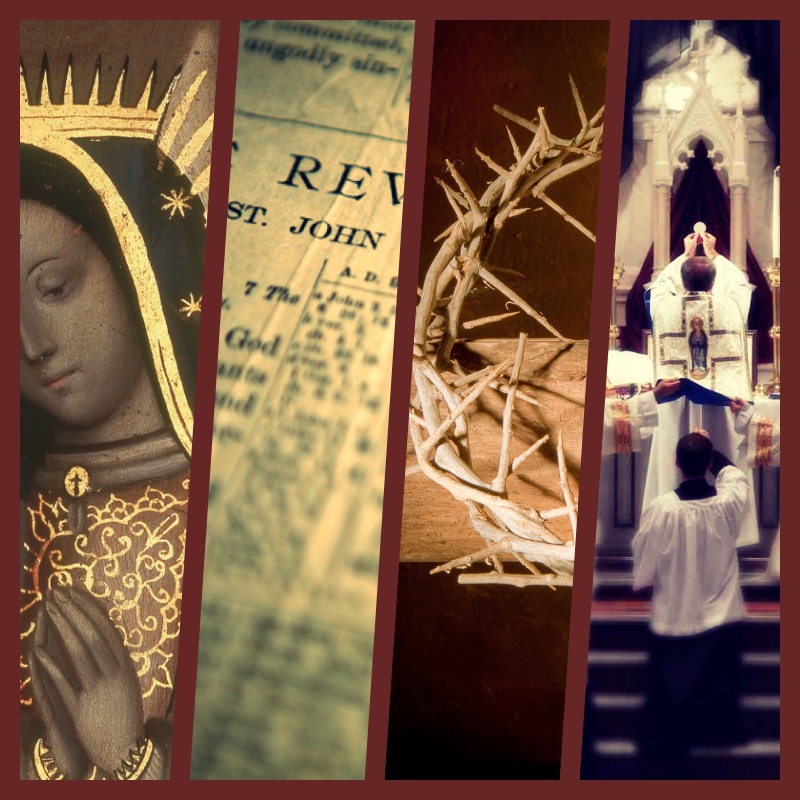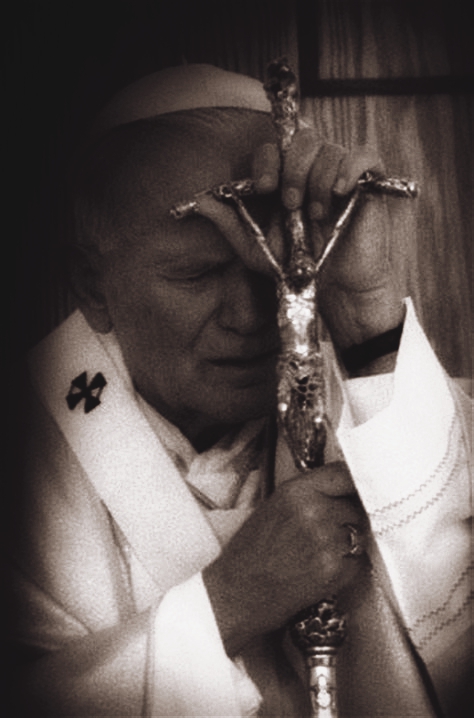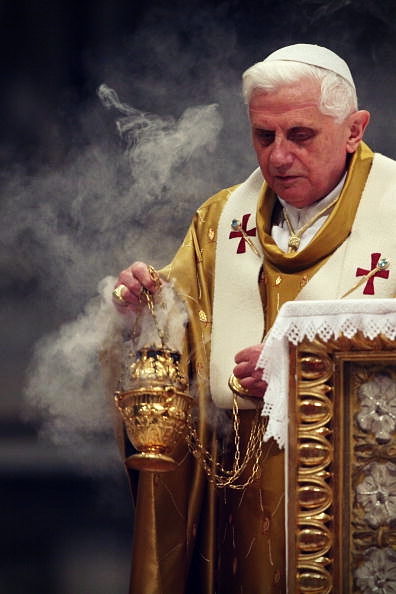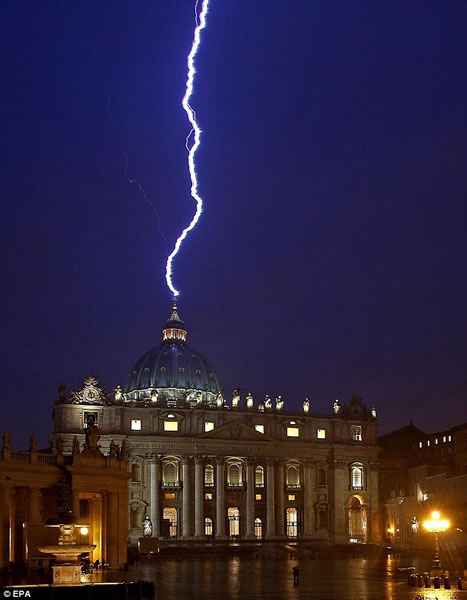
WITHOUT a doubt, the Book of Revelation is one of the most controversial in all of Sacred Scripture. On one end of the spectrum are fundamentalists who take every word literally or out of context. On the other are those who believe the book has already been fulfilled in the first century or who ascribe to the book a merely allegorical interpretation.
But what about future times, our times? Does Revelation have anything to say? Unfortunately, there is a modern tendency among many clergy and theologians to relegate discussion of the prophetic aspects of the Apocalypse to the loony bin, or simply dismiss the notion of comparing our times to these prophecies as dangerous, too complicated, or altogether misguided.
There’s only one problem with that stance, however. It flies in the face of the living Tradition of the Catholic Church and the very words of the Magisterium itself.
TWO CRISES
One might wonder why there is such a hesitation to reflect upon the more obvious prophetic passages of Revelation. I believe it has to do with a general crisis of faith in God’s Word.
There are two major crises in our times when it comes to sacred Scripture. One is that Catholics don’t read and pray with the bible enough. The other is that the Scriptures have been sterilized, dissected, and  diffused by modern exegesis as merely a historical piece of literature rather than the living Word of God. This mechanical approach is one of the defining crises of our time, for it has paved the way for heresy, modernism, and irreverence; it has smothered mysticism, misguided seminarians, and in some if not many cases, shipwrecked the faith of the faithful—clergy and laymen alike. If God is no longer the Lord of miracles, of charisms, of Sacraments, of new Pentecosts and spiritual gifts that renew and build up the Body of Christ… what is He the God of exactly? Intellectual discourse and impotent liturgy?
diffused by modern exegesis as merely a historical piece of literature rather than the living Word of God. This mechanical approach is one of the defining crises of our time, for it has paved the way for heresy, modernism, and irreverence; it has smothered mysticism, misguided seminarians, and in some if not many cases, shipwrecked the faith of the faithful—clergy and laymen alike. If God is no longer the Lord of miracles, of charisms, of Sacraments, of new Pentecosts and spiritual gifts that renew and build up the Body of Christ… what is He the God of exactly? Intellectual discourse and impotent liturgy?
In a carefully worded Apostolic Exhortation, Benedict XVI pointed out the good as well as the bad aspects of the historical-critical method of biblical exegesis. He notes that a spiritual/theological interpretation is essential and complimentary to an historical analysis:
Unfortunately, a sterile separation sometimes creates a barrier between exegesis and theology, and this “ occurs even at the highest academic levels ”. —POPE BENEDICT XVI, Post-Synodal Apostolic Exhortation, Verbum Domini, n.34
“The highest academic levels.” Those levels are often the seminarian level of study meaning that future priests have often been taught a distorted view of Scripture, which in turn has led to…
Generic and abstract homilies which obscure the directness of God’s word… as well as useless digressions which risk drawing greater attention to the preacher than to the heart of the Gospel message. —Ibid. n. 59
One young priest recounted to me how the seminary he attended had so dismantled Scripture that it left the impression that God did not exist. He said many of his friends who did not have his previous formation entered the seminary excited about becoming saints… but after formation, they were completely stripped of their zeal by the modernist heresies they were taught… yet, they became priests. If the shepherds are myopic, what happens to the sheep?
Pope Benedict seems to criticize this very type of biblical analysis, pointing out the serious consequences of limiting oneself to a strictly historical view of the Bible. He notes in particular that the vacuum of a faith-based interpretation of Scripture has often been filled by a secular understanding and philosophy such that…
…whenever a divine element seems present, it has to be explained in some other way, reducing everything to the human element… Such a position can only prove harmful to the life of the Church, casting doubt over fundamental mysteries of Christianity and their historicity—as, for example, the institution of the Eucharist and the resurrection of Christ… —POPE BENEDICT XVI, Post-Synodal Apostolic Exhortation, Verbum Domini, n.34
What does this have to do with the Book of Revelation and a present-day interpretation of its prophetic vision? We cannot view Revelation as merely a historical text. It is the living Word of God. It speaks to us on many levels. But one, as we will see, is the prophetic aspect for today—a level of interpretation strangely rejected by many Scripture scholars.
But not by the popes.
REVELATION AND TODAY
Ironically, it was Pope Paul VI who used a passage from St. John’s prophetic vision to describe, in part, this very crisis of faith in the Word of God.
The tail of the devil is functioning in the disintegration of the Catholic
world. The darkness of Satan has entered and spread throughout the Catholic Church even to its summit. Apostasy, the loss of the faith, is spreading throughout the world and into the highest levels within the Church. —Address on the Sixtieth Anniversary of the Fatima Apparitions, October 13, 1977
It was Paul VI was alluding to Revelation Chapter 12:
Then another sign appeared in the sky; it was a huge red dragon, with seven heads and ten horns, and on its heads were seven diadems. Its tail swept away a third of the stars in the sky and hurled them down to the earth. (Rev 12:3-4)
In the first Chapter, St. John sees a vision of Jesus holding seven stars in His right hand:
…the seven stars are the angels of the seven churches. (Rev 1:20).
The most likely interpretation given by biblical scholars is that these angels or stars represent the bishops or pastors presiding over the seven Christian communities. Thus, Paul VI is referring to apostasy within the ranks of the clergy who are “swept away.” And, as we read in 2 Thess 2, the apostasy precedes and accompanies the “lawless one” or Antichrist whom the Church Fathers also referred to as the “beast” in Revelation 13.
 John Paul II also made a direct comparison of our times to the twelfth chapter of Revelation by drawing a parallel to the battle between the culture of life and the culture of death.
John Paul II also made a direct comparison of our times to the twelfth chapter of Revelation by drawing a parallel to the battle between the culture of life and the culture of death.
This struggle parallels the apocalyptic combat described in [Rev 11:19-12:1-6, 10 on the battle between” the woman clothed with the sun” and the “dragon”]. Death battles against Life: a “culture of death” seeks to impose itself on our desire to live, and live to the full… —POPE JOHN PAUL II, Cherry Creek State Park Homily, Denver, Colorado, 1993
In fact, St. John Paul II explicitly assigns the Apocalypse to the future…
The “enmity,” foretold at the beginning, is confirmed in the Apocalypse (the book of the final events of the Church and the world), in which there recurs the sign of the “woman,” this time “clothed with the sun” (Rev. 12:1). —POPE JOHN PAUL II, Redemptoris Mater, n. 11 (note: text in parenthesis are the Pope’s own words)
Neither did Pope Benedict hesitate to step into the prophetic territory of Revelation applying it to our times:
This fight in which we find ourselves… [against] powers that destroy the world, are spoken of in chapter 12 of Revelation… It is said that the dragon directs a great stream of water against the fleeing woman, to sweep her away… I think that it is easy to interpret what the river stands for: it is these currents that dominate everyone, and want to eliminate the faith of the Church, which seems to have nowhere to stand before the power of these currents that impose themselves as the only way of thinking, the only way of life. —POPE BENEDICT XVI, first session of the special synod on the Middle East, October 10th, 2010
Pope Francis echoed those thoughts when he specifically referred to a novel on the Antichrist, Lord of the World. He compared it to our times and the “ideological colonization” taking place that demands of everyone “the single thought. And this sole thought is the fruit of worldliness… This… is called apostasy.”[1]Homily, November 18th, 2013; Zenit
…those with the knowledge, and especially the economic resources to use them, [have] an impressive dominance over the whole of humanity and the entire world… In whose hands does all this power lie, or will it eventually end up? It is extremely risky for a small part of humanity to have it. —POPE FRANCIS, Laudato si’, n. 104; www.vatican.va
Benedict XVI also interprets “Babylon” in Revelation 19, not as a bygone entity, but as referring to corrupt cities, including those of our times. This corruption, this “worldliness”—an obsession with pleasure— he says, is leading humanity toward slavery.
The Book of Revelation includes among the great sins of Babylon – the symbol of the world’s great irreligious cities – the fact that it trades with bodies and souls and treats them as commodities (cf. Rev 18:13). In this context, the problem
of drugs also rears its head, and with increasing force extends its octopus tentacles around the entire world – an eloquent expression of the tyranny of mammon which perverts mankind. No pleasure is ever enough, and the excess of deceiving intoxication becomes a violence that tears whole regions apart – and all this in the name of a fatal misunderstanding of freedom which actually undermines man’s freedom and ultimately destroys it. —POPE BENEDICT XVI, On the occasion of Christmas Greetings, December 20th, 2010; http://www.vatican.va/
Slavery to whom?
THE BEAST
The answer, of course, is that ancient serpent, the devil. But we read in John’s Apocalypse that the devil gives his “power and his throne and his great authority” to a “beast” that rises out of the sea.
Now, often in historical-critical exegesis, a narrow interpretation is given to this text as referring to Nero or some other early persecutor, thereby suggesting that St. John’s “beast” has already come and gone. However, that is not the strict view of the Church Fathers.
The majority of the Fathers see the beast as representing antichrist: St. Iranaeus, for example, writes: “The beast that rises up is the epitome of evil and falsehood, so that the full force of apostasy which it embodies can be cast into the fiery furnace.” —cf. St. Irenaeus, Against Heresies, 5, 29; The Navarre Bible, Revelation, p. 87
The beast is personified by St. John who sees that it is given “a mouth uttering proud boasts and blasphemies,” and at the same time, is a composite kingdom. [2]Rev 13:5 Once again, St. John Paul II directly compares this external “rebellion” led by the “beast” to what is unfolding at this hour:
Unfortunately, the resistance to the Holy Spirit which St. Paul emphasizes in the interior and subjective dimension as tension, struggle and rebellion taking place in the human heart, finds in every period of history and especially in the modern era its external dimension, which takes concrete form as the content of culture and civilization, as a philosophical system, an ideology, a program for action and for the shaping of human behavior. It reaches its clearest expression in materialism, both in its theoretical form: as a system of thought, and in its practical form: as a method of interpreting and evaluating facts, and likewise as a program of corresponding conduct. The system which has developed most and carried to its extreme practical consequences this form of thought, ideology and praxis is dialectical and historical materialism, which is still recognized as the essential core of Marxism. —POPE JOHN PAUL II, Dominum et Vivificantem, n. 56
In fact, Pope Francis compares the current system—a kind of amalgamation of Communism and capitalism—to a kind of beast that devours:
In this system, which tends to devour everything which stands in the way of increased profits, whatever is fragile, like the environment, is defenceless before the interests of a deified market, which becomes the only rule. —Evangelii Gaudium, n. 56
While still a cardinal, Joseph Ratzinger issued a warning regarding this beast—a warning that should resonate with all in this technological age:

The Apocalypse speaks about God’s antagonist, the beast. This animal does not have a name, but a number [666]. In [the horror of the concentration camps], they cancel faces and history, transforming man into a number, reducing him to a cog in an enormous machine. Man is no more than a function.
In our days, we should not forget that they prefigured the destiny of a world that runs the risk of adopting the same structure of the concentration camps, if the universal law of the machine is accepted. The machines that have been constructed impose the same law. According to this logic, man must be interpreted by a computer and this is only possible if translated into numbers.
The beast is a number and transforms into numbers. God, however, has a name and calls by name. He is a person and looks for the person. —Cardinal Ratzinger, (POPE BENEDICT XVI) Palermo, March 15th, 2000
It is clear, then, that applying the Book of Revelation to our time is not only fair game, but consistent among the pontiffs.
Of course, the Early Church Fathers did not hesitate to interpret the Book of Revelation as a glimpse into future events (see Rethinking the End Times). They taught, according to the living Tradition of the Church, that Chapter 20 of Revelation is a future event in the life of the Church, a symbolic period of a “thousand years” in which, after the beast is destroyed, Christ will reign in His saints in a “period of peace.” In fact, the overwhelming body of modern prophetic revelation speaks precisely of a coming renewal in the Church preceded by great tribulations, including an antichrist. They are a mirror image of the early Church Fathers’ teachings and prophetic words of modern popes (Is Jesus Really Coming?). Our Lord Himself hints that the coming tribulations of the end times does not, therefore, mean that the end of the world is imminent.
…such things must happen first, but it will not immediately be the end. (Luke 21:9)
In fact, Christ’s discourse on the end times is incomplete in so far as He only imparts a compressed vision of the end. This is where the Old Testament prophets and the Book of Revelation provide us further eschatological insights that allow us to decompress Our Lord’s words, thereby gaining a fuller understanding of the “end times.” After all, even the prophet Daniel is told that his visions of the end and the message—which are essentially a mirror of those in the Apocalypse—are to be sealed up “until the end time.” [3]cf. Dan 12:4; see also Is the Veil Lifting? This is why Sacred Tradition and the development of doctrine from the Church Fathers is indispensable. As St. Vincent of Lerins wrote:
… if some new question should arise on which no such decision has been given, they should then have recourse to the opinions of the holy Fathers, of those at least, who, each in his own time and place, remaining in the unity of communion and of the faith, were accepted as approved masters; and whatsoever these may be found to have held, with one mind and with one consent, this ought to be accounted the true and Catholic doctrine of the Church, without any doubt or scruple. —Commonitoryof 434 A.D., “For the Antiquity and Universality of the Catholic Faith Against the Profane Novelties of All Heresies”, Ch. 29, n. 77
For not every word of Our Lord was recorded; [4]cf. John 21:25 some things were passed on orally, not just in writing. [5]cf. The Fundamental Problem
I and every other orthodox Christian feel certain that there will be a resurrection of the flesh followed by a thousand years in a rebuilt, embellished, and enlarged city of Jerusalem, as was announced by the Prophets Ezekiel, Isaias and others… A man among us named John, one of Christ’s Apostles, received and foretold that the followers of Christ would dwell in Jerusalem for a thousand years, and that afterwards the universal and, in short, everlasting resurrection and judgment would take place. —St. Justin Martyr, Dialogue with Trypho, Ch. 81, The Fathers of the Church, Christian Heritage
ISN’T REVELATION JUST A DIVINE LITURGY?
It has been pointed out by several Scripture scholars, from Dr. Scott Hahn to Cardinal Thomas Collins, that the Book of Revelation parallels the Liturgy. From the “Penitential Rite” in the opening chapters to the Liturgy of the Word through the opening of the scroll in Chapter 6; the offertory prayers (8:4); the “great Amen” (7:12); the use of incense (8:3); the candelabra or lampstands (1:20), and so forth. So is this in contradiction to a future eschatological interpretation of Revelation?
the opening of the scroll in Chapter 6; the offertory prayers (8:4); the “great Amen” (7:12); the use of incense (8:3); the candelabra or lampstands (1:20), and so forth. So is this in contradiction to a future eschatological interpretation of Revelation?
On the contrary, it completely supports it. In fact, St. John’s Revelation is a deliberate parallel to the Liturgy, which is the living memorial of the Passion, Death and Resurrection of the Lord. The Church herself teaches that, as the Head went forth, so too will the Body pass through her own passion, death, and resurrection.
Before Christ’s second coming the Church must pass through a final trial that will shake the faith of many believers… The Church will enter the glory of the kingdom only through this final Passover, when she will follow her Lord in his death and Resurrection. —Catechism of the Catholic Church, 675, 677
Only Divine Wisdom could have inspired the Book of Revelation according to the pattern of the Liturgy, while at the same time unfolding the diabolical plans of wickedness against the Bride of Christ and her consequent triumph over evil. Ten years ago, I wrote a series based on this parallel called The Seven Year Trial.
HISTORICAL TOO
A future interpretation of the Book of Revelation does not, therefore, exclude a historical context. As St. John Paul II said, this battle between the “woman” and that ancient serpent is “a struggle that is to extend through the whole of human history.”[6]cf. Redemptoris Mater, n.11 Most certainly, St. John’s Apocalypse also refers to the tribulations in his day. In the letters to the Churches of Asia (Rev 1-3), Jesus is speaking very specifically to the Christians and Jews of that period. At the same time, the words hold a perennial warning for the Church at all times, especially regarding love grown cold and lukewarm faith. [7]cf. First Love Lost In fact, I was stunned to see the parallel between Pope Francis’ closing remarks to the Synod and Christ’s letters to the seven churches (see The Five Corrections).
The answer is not that the Book of Revelation is either historical or only of the future—rather, it is both. The same can be  said of the Old Testament prophets whose words speak of specific local events and historical time frames, and yet, they are written in such a way that they still hold a future fulfillment.
said of the Old Testament prophets whose words speak of specific local events and historical time frames, and yet, they are written in such a way that they still hold a future fulfillment.
For the mysteries of Jesus are not yet completely perfected and fulfilled. They are complete, indeed, in the person of Jesus, but not in us, who are his members, nor in the Church, which is his mystical body. —St. John Eudes, treatise “On the Kingdom of Jesus”, Liturgy of the Hours, Vol IV, p 559
Scripture is like a spiral that, as it circles through time, is fulfilled again and again, on many different levels. [8]cf. A Circle… A Spiral For example, while the Passion and Resurrection of Jesus fulfills the words of Isaiah on the Suffering Servant… it is not complete with regards to His Mystical Body. We have yet to reach the “full number” of Gentiles in the Church, the conversion of the Jews, the rise and fall of the beast, the chaining of Satan, a universal restoration of peace, and the establishment of Christ’s reign in the Church from coastland to coastland after a judgment of the living. [9]cf. The Last Judgments
In days to come, the mountain of the Lord’s house shall be established as the highest mountain and raised above the hills. All nations shall stream toward it… He shall judge between the nations, and set terms for many peoples. They shall beat their swords into plowshares and their spears into pruning hooks; one nation shall not raise the sword against another, nor shall they train for war again. (Isaiah 2:2-4)
The Catholic Church, which is the kingdom of Christ on earth, [is] destined to be spread among all men and all nations… —POPE PIUS XI, Quas Primas, Encyclical, n. 12, Dec. 11th, 1925; cf. Matt 24:14
Redemption will be complete only when all men share his obedience. —Fr. Walter Ciszek, He Leadeth Me, pg. 116-117
TIME OF WATCHING AND PRAYING
Still, Revelation’s apocalyptic vision is often considered taboo among Catholic intellectuals and readily dismissed as “paranoia” or “sensationalism.” But such a viewpoint contradicts Mother Church’s perennial wisdom:
According to the Lord, the present time is the time of the Spirit and of witness, but also a time still marked by “distress” and the trial of evil which does not spare the Church and ushers in the struggles of the last days. It is a time of waiting and watching. —CCC, 672
It is a time of waiting and watching! Waiting for Christ’s return and watching for it—whether it is His Second Coming or  His personal coming at the end of the natural course of our lives. Our Lord Himself said to “watch and pray!“[10]Matt 26:41 What more efficacious way is there to watch and pray than through the inspired Word of God, including the Book of Revelation? But here we need a qualification:
His personal coming at the end of the natural course of our lives. Our Lord Himself said to “watch and pray!“[10]Matt 26:41 What more efficacious way is there to watch and pray than through the inspired Word of God, including the Book of Revelation? But here we need a qualification:
…there is no prophecy of scripture that is a matter of personal interpretation, for no prophecy ever came through human will; but rather human beings moved by the Holy Spirit spoke under the influence of God. (2 Pet 1:20-21)
If we are to watch and pray with the Word of God, it must be with the very Church who wrote and thus interprets that Word.
…the Scripture is to be proclaimed, heard, read, received and experienced as the word of God, in the stream of the Apostolic Tradition from which it is inseparable. —POPE BENEDICT XVI, Post-Synodal Apostolic Exhortation, Verbum Domini, n.7
Indeed, when St. John Paul II called the young to become ‘”morning watchmen” at the dawn of the new millennium,’ he specifically noted that we must “be for Rome and for the Church.”[11]Novo Millennio Inuente, n.9, Jan. 6th, 2001
Thus, one can read the Book of Revelation knowing that the future triumph of Christ and His Church and subsequent defeat of Antichrist and Satan are a present and future reality awaiting fulfillment.
…the hour is coming, and is now here, when true worshipers will worship the Father in Spirit and truth… (John 4:23)
First published November 19th, 2010 with updates today.
RELATED READING:
Followup to this writing: Living the Book of Revelation
Protestants and the Bible: The Fundamental Problem
The Unfolding Splendor of Truth
Your donations are encouragement
and food for our table. Bless you
and thank you.
To journey with Mark in The Now Word,
click on the banner below to subscribe.
Your email will not be shared with anyone.
Footnotes
| ↑1 | Homily, November 18th, 2013; Zenit |
|---|---|
| ↑2 | Rev 13:5 |
| ↑3 | cf. Dan 12:4; see also Is the Veil Lifting? |
| ↑4 | cf. John 21:25 |
| ↑5 | cf. The Fundamental Problem |
| ↑6 | cf. Redemptoris Mater, n.11 |
| ↑7 | cf. First Love Lost |
| ↑8 | cf. A Circle… A Spiral |
| ↑9 | cf. The Last Judgments |
| ↑10 | Matt 26:41 |
| ↑11 | Novo Millennio Inuente, n.9, Jan. 6th, 2001 |


